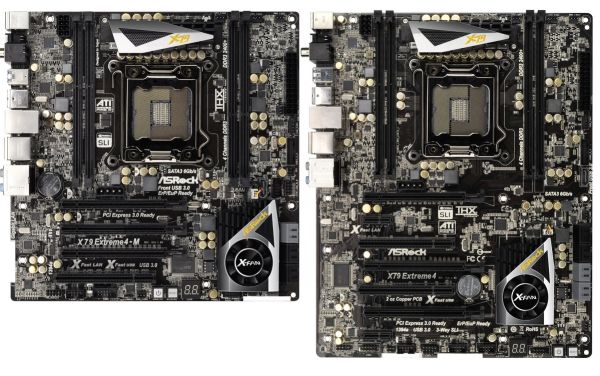ASRock X79 Extreme4-M and X79 Extreme4 Review – Sandy Bridge-E meets mATX
by Ian Cutress on December 9, 2011 12:00 PM EST- Posted in
- Motherboards
- ASRock
- X79
ASRock have released a range of motherboards for X79, and today we have looked at the X79 Extreme4-M, a microATX board with all the Sandy Bridge-E credentials, and its bigger brother, the X79 Extreme4. Along with this, ASRock are also planning on releasing an Extreme3, Extreme7, and an ultimate version Extreme9, all at various price points.
It is good to see a microATX board on the X79 market, despite the host of problems that it presents – the premium of space, the ability to use (and abuse) all the additional benefits X79 to offer, and the potential of making the board a lot cheaper than the full ATX brethren. ASRock are offering the X79 Extreme4-M for one cent less than $225 (MSRP), compared to the larger X79 Extreme4, which weighs in at just less than $235 (MSRP). In an age of austerity, a few dollars here and there can count, even if you splash out on an X79 and Sandy Bridge-E system.
However, there are points to note. These two boards are considerably cheaper than the ASUS P9X79-V Pro and Intel DX79SI I have reviewed so far. So, as you would expect, there are a couple of features you might not get. The biggest one to note is the memory – while on all the boards we have quad channel, for the smaller sum of money you only get one DIMM per channel, compared to two DIMMs per channel on the more expensive boards. As a personal option, this affects fewer people than you may think – of all the people who are going X79, enthusiasts (as opposed to professionals) rarely need more than 16 GB of memory. Given the low cost of 4GB DDR3 sticks, these ASRock boards can easily be filled with memory at little cost. If you need more, you could look at 8 GB sticks just coming onto the market, otherwise yes, you will need two DIMMs per channel motherboard.
In comparison between the two ASRock boards, you get a lot more than $10 difference in terms of extras on the full size ATX X79 Extreme4 than the price difference suggests – more PCIe slots and space for add-on cards, more SATA 6 Gbps ports and more in the box in terms of cables and SLI connectors. Thanks to the extra space, the PCIe x16 slots are also more beneficial for airflow in dual GPU setups on the Extreme4. As a result, you may see the mATX Extreme4-M being sold with small discounts (e.g. currently $219 at time of writing, saving £6) to reflect the true difference.
The Extreme4 also performs slightly better, especially in the memory overclock, though that may be down to the updated BIOS version which ASRock had not released for the Extreme4-M at the time of testing. Nevertheless, the Extreme4 would be my choice if I had to choose between these two boards for performance. If you absolutely need a mATX board, the Extreme4-M is not a bad choice. However, you will not be pushing any of the boards too hard on a CPU overclock. And for the noise conscious, you will definitely have to change that default CPU fan setting of a constant 100%.











54 Comments
View All Comments
DigitalFreak - Friday, December 9, 2011 - link
I wish PCI connectors on motherboards would die already, especially on the high end.futurepastnow - Friday, December 9, 2011 - link
I agree with you, but I'm sure the three people who still use sound cards will be here shortly to tell you you're wrong.geniekid - Friday, December 9, 2011 - link
I would be one of those people. If you're into amateur music production, you're probably going to need a sound card for various inputs/outputs, and a lot of the cheaper options there are going to be PCI.Also, my month-old built HTPC uses the PCI for a wireless network adapter.
cjs150 - Friday, December 9, 2011 - link
I rumaged around the various PCs I have and the best I come up with is a 6 year old RAID card (still a good one) and a 2 year old TV cardSo time for PCI to die
Can I have a right angled 24 ATX socket as well
somedude1234 - Friday, December 9, 2011 - link
If you're purchasing a new motherboard and CPU, each of which is north of $200, does the additional cost burden of a PCIe sound card or WLAN card really make that big of a difference?I understand that every dollar saved somewhere can be used (more memory, bigger SSD, etc.), but PCIe sound cards and WLAN cards aren't exactly bank-breakers.
I don't do any serious audio work, so are there any technical reasons (latency or otherwise) that make legacy PCI cards better than their PCIe counterparts?
Spivonious - Friday, December 9, 2011 - link
No technical reasons, but many audio production cards (i.e. not the latest Soundblaster) are still only available in a PCI format.Flunk - Friday, December 9, 2011 - link
The latest soundblaster IS actually available in PCI-E. If the PCI slots went away everything would be available in PCI-E. There really is no reason anymore.Gnarr - Friday, December 9, 2011 - link
no-one who's serious about music production uses a soundblaster..g00ey - Saturday, December 10, 2011 - link
That is not true at all, most serious brands of professional audio hardwareg00ey - Saturday, December 10, 2011 - link
That is not true at all, most serious brands of professional audio hardware such as RME, UAD, Apogee, or even AVID/Digidesign dominate their product lines with PCIe based expansion cards and not PCI.Also, there is a considerable variety of PCIe to PCI adapters and bridgeboards out there that makes it even less justifiable to put PCI slots on a modern motherboard.